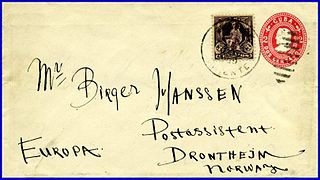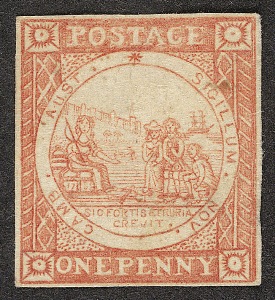
In philately, a cut-out is an imprinted stamp cut from an item of postal stationery such as a postal card, letter sheet, aerogramme or wrapper that may have been used as a normal stamp. [1] [2]

In philately, a cut-out is an imprinted stamp cut from an item of postal stationery such as a postal card, letter sheet, aerogramme or wrapper that may have been used as a normal stamp. [1] [2]
In Great Britain the postal use of cut-outs was banned under the Post Office Act of 1870. This prohibition was in force until 31 December 1904. [3] In 1905, Herbert L'Estrange Ewen published a booklet "The Unadhesive Postage Stamps of the UK" meaning postal stationery cut-outs. [4]

A cut square has been cut in a square or rectangular shape. [5] [6] An alternative use of the term is simply any stamp, from sheets or postal stationery, cut in a square or rectangular shape and not cut to shape. [7] [8]
It is distinguished from the entire (the complete postal stationery item) or the more common practice of earlier eras of cutting to shape by removing all of the paper apart from the imprinted stamp. A variant of the cut square is the full corner which is a cutting of the corner to include the intact flap and back of the envelope as well as the front. [9]
Just as used postage stamps were cut out, soaked and placed in an album, collectors also cut out postal stationery indicia and mounted them conveniently in albums. Now, the practice is frowned upon by most collectors who collect the entire, [10] thus saving the envelope's postal history, the knife of the envelope and the postmark. To illustrate how far things have shifted in emphasis from the collection of cut squares, the most recent United Postal Stationery Society publication on US 20th and 21st century stamped envelopes does not even mention cut squares, [11] whereas its predecessor edition, just seven years earlier, devoted a section to their pricing. [12]
The term cut square is differentiated from the term used on piece which denotes an adhesive stamp cut out in similar fashion from the original cover so as to preserve the entire postmark. [13]

Cut to shape refer to a indicium that has been cut to the shape of the design, such as an octagon, circle or oval, instead of simply cut into a square or rectangular shape. [5]
Stamps cut to shape almost always command a lower price than those that have been cut square, and sometimes have little or no value, especially envelope indicia cut to shape. Although many stamps unfortunately have been cut to shape by stamp collectors, some early stamps were produced without perforations and were often cut to shape by people before they affixed the stamps to their envelopes. This is true, for example, for the octagon-shaped 4 Annas stamp of India issued in 1854, which is most commonly found cut to shape on envelopes or pieces.
All of the surviving examples of the India 1854 (inverted head) are postally used. Only two (or three) are known cut square; another 24 or so, are cut to shape (in an octagonal shape). One from the collection of the Earl of Crawford was exhibited in the World Philatelic Exhibition in Washington in 2006. [14]
The "world's most famous stamp" — the unique 1856 British Guiana 1c magenta — is cut into an octagonal shape. Consequently, it has been referred to as being cut to shape, [5] although technically that term is incorrect as the stamp design is rectangular in shape.

Philately is the study of postage stamps and postal history. It also refers to the collection and appreciation of stamps and other philatelic products. While closely associated with stamp collecting and the study of postage, it is possible to be a philatelist without owning any stamps. For instance, the stamps being studied may be very rare or reside only in museums.

Stamp collecting is the collecting of postage stamps and related objects. It is an area of philately, which is the study of stamps. It has been one of the world's most popular hobbies since the late nineteenth century with the rapid growth of the postal service, as a stream of new stamps was produced by countries that sought to advertise their distinctiveness through their stamps.

An envelope is a common packaging item, usually made of thin, flat material. It is designed to contain a flat object, such as a letter or card.
In philately, gum is the substance applied to the back of a stamp to enable it to adhere to a letter or other mailed item. The term is generic, and applies both to traditional types such as gum arabic and to synthetic modern formulations. Gum is a matter of high importance in philately.

A piece of postal stationery is a stationery item, such as a stamped envelope, letter sheet, postal card, lettercard, aerogram or wrapper, with an imprinted stamp or inscription indicating that a specific rate of postage or related service has been prepaid. It does not, however, include any postcard without a pre-printed stamp, and it is different from freepost for preprinted cards issued by businesses. In general, postal stationery is handled similarly to postage stamps; sold from post offices either at the face value of the printed postage or, more likely, with a surcharge to cover the additional cost of the stationery. It can take the form of an official mail issue produced only for the use of government departments.

This is an overview of the postage stamps and postal history of Denmark.

A stamped envelope or postal stationery envelope (PSE) is an envelope with a printed or embossed indicium indicating the prepayment of postage. It is a form of postal stationery.
This is a list of philatelic topics.

This is a survey of the postage stamps and postal history of New South Wales, a former British colony now part of Australia.

The British Central Africa Protectorate existed in the area of present-day Malawi between 1891 and 1907.

In philately, indicia are markings on a mail piece showing that postage has been prepaid by the sender. Indicia is the plural of the Latin word indicium, meaning distinguishing marks, signs or identifying marks. The term imprinted stamp is used more or less interchangeably, but some indicia are not imprinted stamps. One example is the handstamp, which can be seen in a photo on this page.

The postage stamps of Ireland are issued by the postal operator of the independent Irish state. Ireland was part of the United Kingdom of Great Britain and Ireland when the world's first postage stamps were issued in 1840. These stamps, and all subsequent British issues, were used throughout Ireland until the new Irish Government assumed power in 1922. Beginning on 17 February 1922, existing British stamps were overprinted with Irish text to provide some definitives until separate Irish issues became available within the new Irish Free State. Following the overprints, a regular series of definitive stamps was produced by the new Department of Posts and Telegraphs, using domestic designs. These definitives were issued on 6 December 1922, the day that the Irish Free State officially came into existence; the first was a 2d stamp, depicting a map of Ireland. Since then new images, and additional values as needed, have produced nine definitive series of different designs.

The Inverted Head Four Annas of India is a postage stamp prized by collectors. The 1854 first issues of India included a Four Annas value in red and blue. It was one of the world's first multicolored stamps; the Basel Dove preceded it by nine years. However, an invert error occurred during production, showing the head "upside down."

A specimen stamp is a postage stamp or postal stationery indicium sent to postmasters and postal administrations so that they are able to identify valid stamps and to avoid forgeries. The usual method of invalidating the stamps is either overprinting in ink or perforating the word Specimen across the stamp and where English is not the common language, the words Muestra (Spanish), Monster (Dutch), Muster (German) or Образец have been used instead.

In philately, the vignette is the central part of a postage stamp design, such as, a monarch's head or a pictorial design, which often shades off gradually to the edges of the stamp.

In philately, an imprinted stamp is a stamp printed onto a piece of postal stationery such as a stamped envelope, postal card, letter sheet, letter card, aerogram or wrapper. The printing may be flat upon the surface of the paper, or embossed with a raised relief. An imprinted stamp is also known as unadhesive stamp or indicium.

Herbert Edgar Weston, or H. Edgar Weston, was a stamp dealer in Stockwell, London, then Twickenham, who used the pseudonym Victor Marsh and who purchased Jean-Baptiste Moens' stock of philatelic literature after Moens' retirement in about 1907. Weston claimed to have the world's largest stock of philatelic literature for sale. He was also a prolific producer of philatelic covers using cut-outs from stamped to order postal stationery items. In 1907, Weston was a founder member of the Philatelic Literature Society.

A meter stamp, or meter mark, is the impression made by a postage meter machine that indicates that postage has been paid on a letter or parcel. Meter stamps are widely used by businesses and organisations as they are more efficient than using postage stamps.
Knife is the cutting die for envelope or wrapper blanks. It is called a knife rather than a die because the latter is an object that makes an embossed printed impression of the stamp or indicium on the envelope. Traditionally, a knife would normally be made of forged steel. It was placed on a stack of paper with the sharp edge against the paper. The press head forced the cutting edge all the way through the stack of paper. The cut blanks were removed from the knife and the process was repeated. Not only could it cut out the odd shape of an envelope, but a knife could be used to cut out shapes of airmail stickers or gummed labels in the shape of stars or circles. The variety of shapes a knife could cut would be infinite.

In philately a wrapper is a form of postal stationery which pays the cost of the delivery of a newspaper or a periodical. The wrapper is a sheet of paper, large enough to wrap around a folded or rolled newspaper and with an imprinted stamp to pay the cost of postage. Some catalogs and reference books refer to a wrapper as postal bands which comes from the French term bandes postale. Still others refer to it as a newspaper wrapper or periodical wrapper.